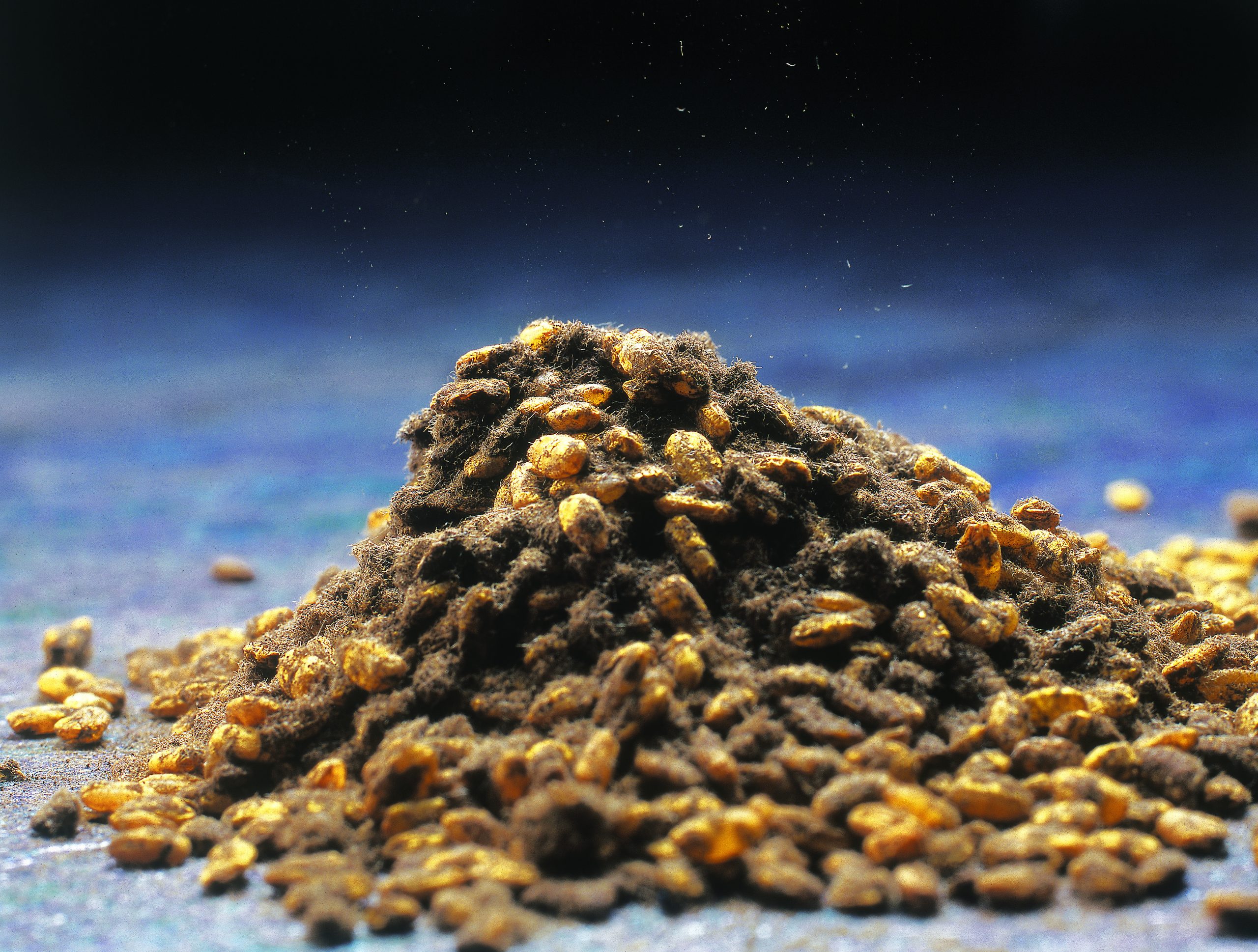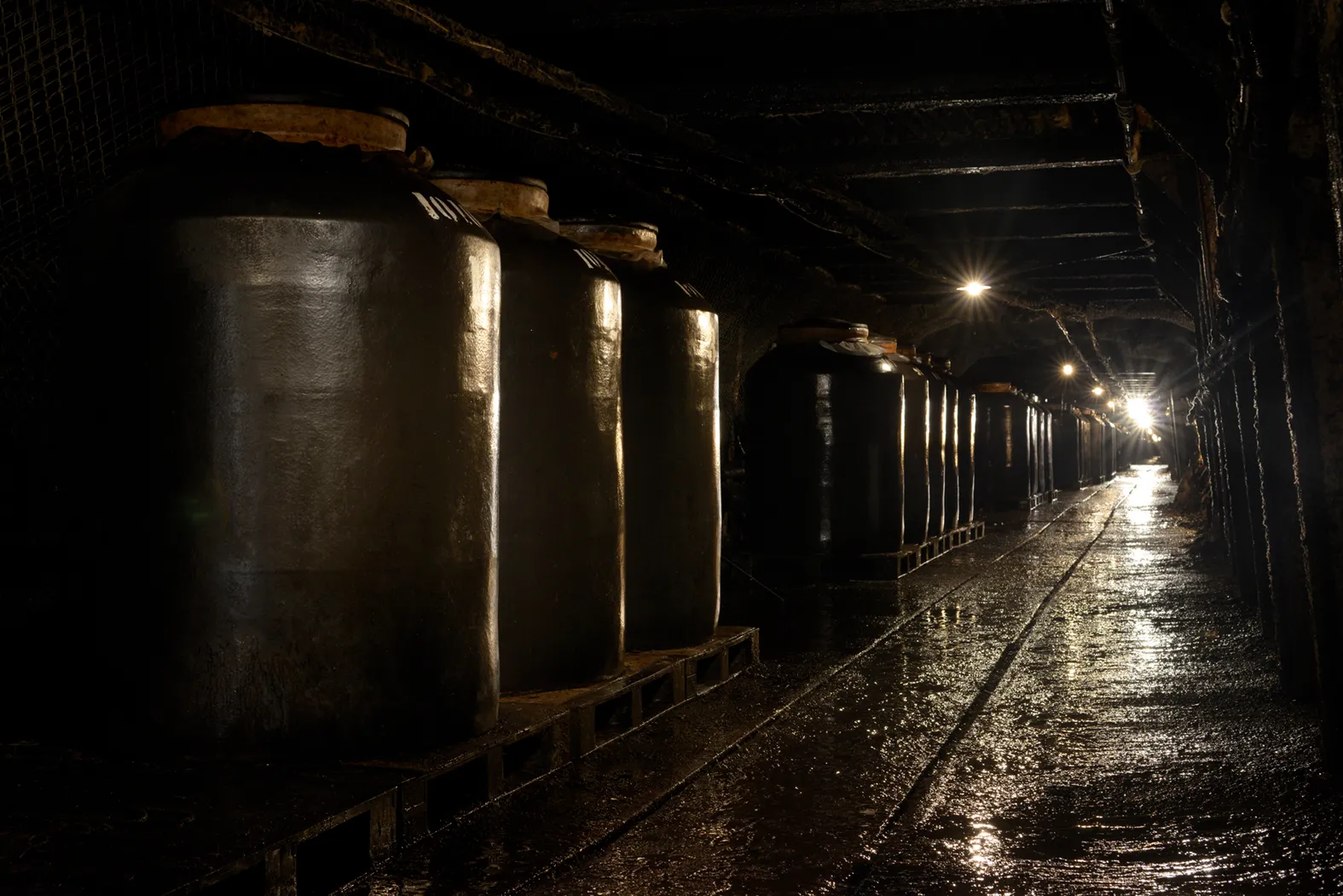Satsuma Shochu Kinzangura RED

A premium that goes beyond. A refined, elegant aroma that originate from gold koji prevails on the nose before a mellow and deep finish that only the mine storage process can provide.
A sweet potato-based honkaku shochu of Satsuma (present-day Kagoshima), crafted only using local potatoes and rice koji made wholly from domestic rice. Both are fermented with gold koji mold before being stored into special crocks deep inside the mine tunnels of Mount Kinzan.
Gold koji adds a refined freshness to the nose, with a full-bodied, rich flavor on the palate and finish, achieved by the unique aging process in the mine.
- Category
- Sweet Potato Honkaku Shochu (Aged 5+ Years)
- Raw ingredients
- Kogane-Sengan Sweet Potato (Kagoshima Prefecture), Rice Koji (Domestic Rice)
- Koji mold
- Gold
- Alcohol
- 35%

The one-of-its-kind, Gold Koji
Koji mold has been an essential part of shochu production. There are three commonly known forms of koji: black, white, and yellow, each of which can offer different aroma and flavor to the resulting shochu.
For most of its history, shochu making in Kagoshima almost always involved the use of black koji mold. That was until 1911, when Dr. Ryoji Nakazawa discovered Gold Koji, a spontaneously mutated form of black koji mold, at the Central Research Institute of the then General-Government of Taiwan. Koji is a living organism, and this gold koji was found to be a particularly tricky one to maintain in quality. Because of this, it was not used again for a long time. The one-of-its-kind, Gold Koji.

Storage and Aging Processes in the Kinzan Mine. What Makes it Unique?
How does the environment of the mine tunnels affect the shochu products at the Satsuma Shochu Kinzangura distillery? The first thing that should be noted is the lack of exposure to sunlight. In other words, shochu experiences very little spoilage or degradation by ultraviolet rays. Another important feature in the mine is the minimal fluctuation in temperature and humidity all year around. The temperature in winter is round about 16°C, while in summer it hovers around 19°C.
The humidity always remains as high as around 90% throughout the year. Incidentally, this constant temperature and humidity is also known to be suited for resting whiskey and wine. This is due to the fact that in such environment, in which the summer temperature is in 20°C or lower and humidity remains high, the aromatics of shochu are less likely to be lost through evaporation. As a result, the shochu develops a more mellow and rich flavor profile.
The one-of-its-kind, Gold Koji
Koji mold has been an essential part of shochu production. There are three commonly known forms of koji: black, white, and yellow, each of which can offer different aroma and flavor to the resulting shochu.
For most of its history, shochu making in Kagoshima almost always involved the use of black koji mold. That was until 1911, when Dr. Ryoji Nakazawa discovered Gold Koji, a spontaneously mutated form of black koji mold, at the Central Research Institute of the then General-Government of Taiwan. Koji is a living organism, and this gold koji was found to be a particularly tricky one to maintain in quality. Because of this, it was not used again for a long time. The one-of-its-kind, Gold Koji.
Storage and Aging Processes in the Kinzan Mine. What Makes it Unique?
How does the environment of the mine tunnels affect the shochu products at the Satsuma Shochu Kinzangura distillery? The first thing that should be noted is the lack of exposure to sunlight. In other words, shochu experiences very little spoilage or degradation by ultraviolet rays. Another important feature in the mine is the minimal fluctuation in temperature and humidity all year around. The temperature in winter is round about 16°C, while in summer it hovers around 19°C.
The humidity always remains as high as around 90% throughout the year. Incidentally, this constant temperature and humidity is also known to be suited for resting whiskey and wine. This is due to the fact that in such environment, in which the summer temperature is in 20°C or lower and humidity remains high, the aromatics of shochu are less likely to be lost through evaporation. As a result, the shochu develops a more mellow and rich flavor profile.

The one-of-its-kind, Gold Koji
Koji mold has been an essential part of shochu production. There are three commonly known forms of koji: black, white, and yellow, each of which can offer different aroma and flavor to the resulting shochu.
For most of its history, shochu making in Kagoshima almost always involved the use of black koji mold. That was until 1911, when Dr. Ryoji Nakazawa discovered Gold Koji, a spontaneously mutated form of black koji mold, at the Central Research Institute of the then General-Government of Taiwan. Koji is a living organism, and this gold koji was found to be a particularly tricky one to maintain in quality. Because of this, it was not used again for a long time. The one-of-its-kind, Gold Koji.

Storage and Aging Processes in the Kinzan Mine. What Makes it Unique?
How does the environment of the mine tunnels affect the shochu products at the Satsuma Shochu Kinzangura distillery? The first thing that should be noted is the lack of exposure to sunlight. In other words, shochu experiences very little spoilage or degradation by ultraviolet rays. Another important feature in the mine is the minimal fluctuation in temperature and humidity all year around. The temperature in winter is round about 16°C, while in summer it hovers around 19°C.
The humidity always remains as high as around 90% throughout the year. Incidentally, this constant temperature and humidity is also known to be suited for resting whiskey and wine. This is due to the fact that in such environment, in which the summer temperature is in 20°C or lower and humidity remains high, the aromatics of shochu are less likely to be lost through evaporation. As a result, the shochu develops a more mellow and rich flavor profile.

